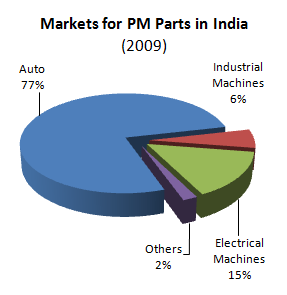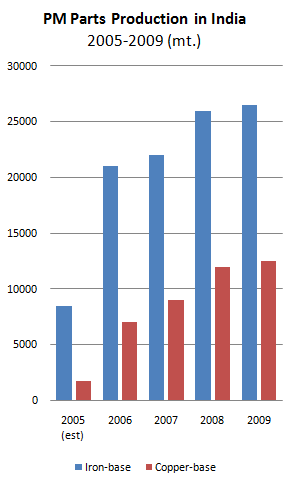The story of Powder Metallurgy in India
India is today an important producer and consumer of PM parts and an important member of the international PM community. To conclude his series of reports from India’s PM11 conference and exhibition, Professor Ramamohan Tallapragada looks back at the story of PM in India. In this brief overview, recent industry figures are presented as well as a view to the future.
The introduction of PM in India
The story of Powder Metallurgy in India dates back to the latter half of 1950’s, when two entrepreneurs, Mr Upadhyaye of M/s Siemetals Ltd., Mumbai, and Mr Bhat of M/s Flexicons Ltd., Udhana, established the production of porous components.
Academic and research backing for the development of the industry followed. This was provided by Prof. G S Tendolkar, initially from BARC and later from I.I.T. Bombay, and also Dr. R. V. Tamhankar from the Defence Metallurgical Research Laboratory, originally based in Ichapur and later from Hyderabad.
The earliest industry suppliers were Mr Korlekar, a manufacturer of sintering furnaces, with metal powders supplied by Mr Sudhakar Thattey.
Following the successful establishment of porous PM components production, the production of hardmetal and high speed steel tools followed, with plants established by Sandvik Asia Ltd., Indian Tool Manufacturers Ltd., and India Hard Metals Ltd. Mr N M Pai of Powder Metals & Alloys also started the production of electrical contacts.
Together, these individuals can be regarded as responsible for the initiation of PM in India.
The expansion of structural PM components production
The significant growth of PM in India began when Mahindra Group established Mahindra Sintered Products in Pune. This was followed by Goa Sintered Products in Margoa, Sundram Fasteners in Hosur, and Widia in Bangalore.
Today there are over 70 manufacturers involved in the industry, ranging from powder producers to manufacturers of sintered metallic and ceramic components. In 2009 India produced around 39,000 tons of PM parts, relying largely on the automotive sector for sales.
A substantial amount of PM related R&D work is today carried out in more than 15 national institutes and laboratories.
Indian automobile production drives PM
The PM industry, whether it be structural PM parts, carbide tools, sintered magnets or self lubricating bearings, is heavily reliant on the automotive sector. Globally, around 80% of all structural PM parts manufactured are used in vehicle production and it is clear that the state of the automotive industry significantly affects the development of the PM industry.
According to data published by the Asian Powder Metallurgy Association (APMA), the Indian PM industry is no different, with around 77% of all structural parts destined for this sector (see Fig. 1).
India is currently the seventh largest vehicle manufacturer in the world and is expected to rise to be the fourth largest by 2014. Annual domestic motor vehicle sales (Apr ’09 – Mar ’10) were 12.29 million, including passenger vehicles (1.95 million), commercial vehicles (0.53 million), two-wheelers (9.37 million) and three-wheelers (0.44 million).
Currently, a four wheeler made in India uses 5- 6 Kg of PM parts, while two and three wheelers use around 150g per vehicle.
Despite the global recession, the Indian automotive industry achieved growth of 12.88% in 2009, in strong contrast to North America and Europe where sales slumped. This, it can be suggested, reflects the shift in the importance of automotive markets towards China and India.
A wide range of PM parts are today produced in India, including the following automotive parts:
- Bushes and bearings
- Engine mounting bearing caps
- Fuel injection components
- Rotors & Gears for oil pumps
- Shock absorber components
- Sprockets
- Synchroniser hubs
- Thrust plates
- Timing pulleys
- Valve train components
The challenges for the Indian PM industry
There are two main factors for the inadequate spread of PM within India. First and foremost is the lack of awareness amongst OEM’s regarding the capabilities of PM technology. The Indian PM trade association, PMAI, however is doing its best to rectify this with the organisation of conferences, seminars and courses aimed at potential end users.
The second factor is that of the availability of some domestic raw materials and production equipment. There is, for example, no producer of tailor made powders for metal injection moulding (MIM) in India. There is also a need for powder forging capability to enable the production of high density high performance PM parts. It seems that part manufactures are reluctant to invest unless there is a demand, while OEM’s require a ready to use product.
Currently there are a few gas and water atomisation plants producing stainless and alloy steels, for which there is limited local demand as they require higher sintering temperatures for processing. There is also production of spherical bronze and copper powders of sizes above 20 micrometers, however such powders are above the preferred size for MIM.
A few manufacturers have, however, recently upgraded facilities and have started supplying stainless steel parts.
A rise to the next level of PM technology, which would enable the production of around 12 Kg of PM products per vehicle, requires a paradigm shift in technology possibly either through joint ventures or through participation of multinationals in Indian PM Industry.
If this happens the market for PM components could soon be doubled to 45,000 tons per year.
Reports published on ipmd.net from the recent PM11 Conference held in India include:
-
PM-11 Conference Report: Graphite selection for use in PM parts production
-
PM-11 Conference Report: The effect of iron powder dilution on properties of M3/2 sintered compacts
-
PM-11 Conference Report: Energy consumption in Powder Metallurgy production
-
PM-11 Conference Report: Trends in PM applications and technologies
-
PM-11 Conference Report: India attracts a global audience
News | Articles | Market reviews | Search directory | Subscribe to e-newsletter







